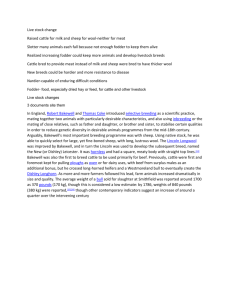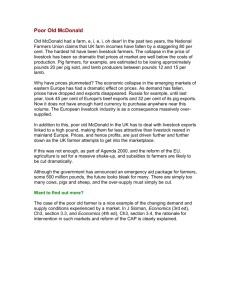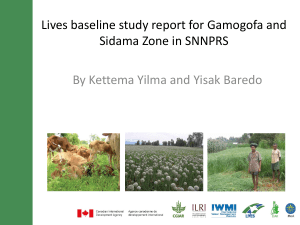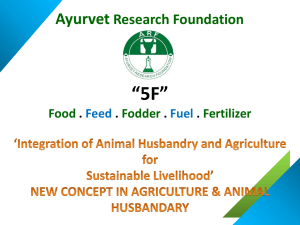Group work - ARARI and SARI ed
advertisement
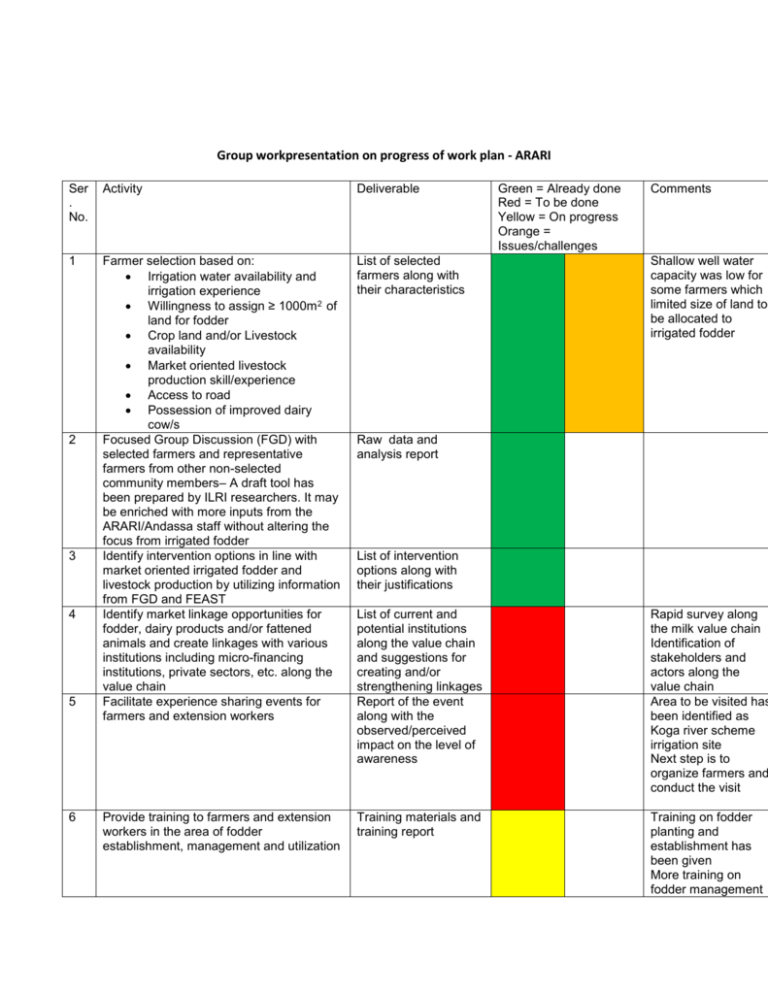
Group workpresentation on progress of work plan - ARARI Ser . No. Activity Deliverable 1 Farmer selection based on: Irrigation water availability and irrigation experience Willingness to assign ≥ 1000m 2 of land for fodder Crop land and/or Livestock availability Market oriented livestock production skill/experience Access to road Possession of improved dairy cow/s Focused Group Discussion (FGD) with selected farmers and representative farmers from other non-selected community members– A draft tool has been prepared by ILRI researchers. It may be enriched with more inputs from the ARARI/Andassa staff without altering the focus from irrigated fodder Identify intervention options in line with market oriented irrigated fodder and livestock production by utilizing information from FGD and FEAST Identify market linkage opportunities for fodder, dairy products and/or fattened animals and create linkages with various institutions including micro-financing institutions, private sectors, etc. along the value chain Facilitate experience sharing events for farmers and extension workers List of selected farmers along with their characteristics List of current and potential institutions along the value chain and suggestions for creating and/or strengthening linkages Report of the event along with the observed/perceived impact on the level of awareness Rapid survey along the milk value chain Identification of stakeholders and actors along the value chain Area to be visited has been identified as Koga river scheme irrigation site Next step is to organize farmers and conduct the visit Provide training to farmers and extension workers in the area of fodder establishment, management and utilization Training materials and training report Training on fodder planting and establishment has been given More training on fodder management 2 3 4 5 6 Green = Already done Red = To be done Yellow = On progress Orange = Issues/challenges Comments Shallow well water capacity was low for some farmers which limited size of land to be allocated to irrigated fodder Raw data and analysis report List of intervention options along with their justifications 7 Facilitate planting of forages by around 36 farmers, some in association with IWMI and Bahir Dar University and some additional farmers. Data outlining names of farmers, areas planted, species planted. 8 Inventory of the available feed stuff with the target farmers and develop a proper feeding ration for the agreed mode (dairy, small ruminants fattening, large ruminants fattening) of livestock production Sampling and assessment of quantity and quality of the feed including irrigated forages used by farmers for feeding to agreed livestock type assessment Ration formula for the different livestock production based on the available feed stuff 10 Collect, analyze and validate field agronomic data, farmers’ field book data for the irrigated forages and livestock productivity Report of the agronomic performance of the planted forages and Animal performance fed the irrigated fodder 11 Conduct farmers’ participatory assessment of the planted forages and Field day Assessment tool and Report of the assessment 12 Conduct cost-benefit analysis of the irrigated fodder production with the project farmers Survey tool and report of the survey 13 Documentation (including visual/audio) of all steps of the fodder development and assessment processes Progress reports (quarterly/biannually /annually) 9 Report on the yield and quality of the feed and utilization has been planned to be given in due course Napier grass was planted by 17 farmers on a total are of 1580 m2 (93m2/farmer) Free grazing is a challenge Some forage plots are far from the water source and delivery hoses are short Survey will be done using checklist Feed sample collection will be done for both the local feeds and the irrigated fodder and quantifying the available feed resources Cost of laboratory analysis of the feed samples might be high Soil sample has been taken by the MSc student Agronomic data and farmer’s field book data collection has been started using farmer Impact of planted forages on livestock productivity (milk yield) will be assessed Field day will be organized Data collection by MSc student and ARARI staff will start soon On progress Group work presentation on progress of work plan - SARI Ser . No. Activity Deliverable 1 Farmer selection based on: Irrigation water availability and irrigation experience Willingness to assign ≥ 1000m 2 of land for fodder Crop land and/or Livestock availability Market oriented livestock production skill/experience Access to road Possession of improved dairy cow/s Focused Group Discussion (FGD) with selected farmers and representative farmers from other non-selected community members– A draft tool has been prepared by ILRI researchers. It may be enriched with more inputs from the SARI/Areka staff without altering the focus from irrigated fodder Identify intervention options in line with market oriented irrigated fodder and livestock production by utilizing information from FGD and FEAST Identify market linkage opportunities for fodder, dairy products and/or fattened animals and create linkages with various institutions including micro-financing institutions, private sectors, etc. along the value chain List of selected farmers along with their characteristics 5 Facilitate experience sharing events for farmers and extension workers 6 Provide training to farmers and extension workers in the area of fodder establishment, management and utilization Facilitate planting of forages by around 36 farmers, some in association with IWMI and Arba Minch University and some additional farmers. Inventory of the available feed stuff with the target farmers and develop a proper feeding ration for the agreed mode (dairy, Report of the event along with the observed/perceived impact on the level of awareness Training materials and training report 2 3 4 7 8 Green = Already done Red = To be done Yellow = On progress Orange = Issues/challenges Comments Difficult to allocate land ≥ 1000 m2. Land requirement should be reduced to 100 – 200m2 Raw data and analysis report List of intervention options along with their justifications List of current and potential institutions along the value chain and suggestions for creating and/or strengthening linkages Data outlining names of farmers, areas planted, species planted. Ration formula for the different livestock production based on What about including additional forage options: Legumes like Tree Lucerne? Potential stakeholders for the activity include: BoA, Rearch Center, Universities, Cooperatives, Micro finance, Forage traders Planting time and seed source should be determined now Clearer procedure on feed sampling, nutrient analysis and 9 10 small ruminants fattening, large ruminants fattening) of livestock production Sampling and assessment of quantity and quality of the feed including irrigated forages used by farmers for feeding to agreed livestock type assessment Collect, analyze and validate field agronomic data, farmers’ field book data for the irrigated forages and livestock productivity 11 Conduct farmers’ participatory assessment of the planted forages and Field day 12 Conduct cost-benefit analysis of the irrigated fodder production with the project farmers Documentation (including visual/audio) of all steps of the fodder development and assessment processes 13 the available feed stuff ration formulation Report on the yield and quality of the feed Report of the agronomic performance of the planted forages and Animal performance fed the irrigated fodder Assessment tool and Report of the assessment Survey tool and report of the survey We don’t have enough information on Lemo Progress reports (quarterly/biannually /annually) On progress
